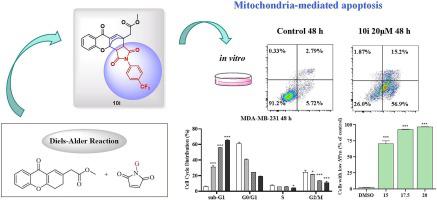当前位置:
X-MOL 学术
›
Bioorg. Med. Chem.
›
论文详情
Our official English website, www.x-mol.net, welcomes your feedback! (Note: you will need to create a separate account there.)
Caged xanthone derivatives to promote mitochondria-mediated apoptosis in breast cancer cells
Bioorganic & Medicinal Chemistry ( IF 3.5 ) Pub Date : 2024-03-12 , DOI: 10.1016/j.bmc.2024.117655 Youyi Wang , Huimin Zheng , Xue Jiang , Huaimo Wu , Yi Ren , Zhichao Xi , Changwu Zheng , Hongxi Xu
Bioorganic & Medicinal Chemistry ( IF 3.5 ) Pub Date : 2024-03-12 , DOI: 10.1016/j.bmc.2024.117655 Youyi Wang , Huimin Zheng , Xue Jiang , Huaimo Wu , Yi Ren , Zhichao Xi , Changwu Zheng , Hongxi Xu

|
Caged xanthones represent a class of natural secondary metabolites exhibiting significant potential as antitumor agents. These compounds are characterized by their distinct cage-like structures, which offer novel and compelling frameworks for drug design. Nonetheless, there exists a dearth of research focused on the structural modification of these compounds, particularly in relation to their cage-like architectures. This study aims to address this gap by introducing an innovative synthetic method for constructing a novel caged structure that incorporates a widely employed maleimide group. Drawing upon the well-established synthetic approach for dihydroxanthones previously developed within our research group, we successfully synthesized 13 new caged xanthones using the Diels-Alder reaction. Subsequently, we evaluated their anti-proliferative activity against HepG2, A549, and MDA-MB-231 cell lines. The results revealed that compound exhibited IC values of 15.86 µM ± 1.29, 19.27 µM ± 1.58, and 12.96 µM ± 0.09 against these cell lines, respectively. Further investigations into the mechanism of action of demonstrated its ability to induce G2/M cell cycle arrest and initiate mitochondria-mediated apoptosis in breast cancer cells.
中文翻译:

笼状氧杂蒽酮衍生物促进乳腺癌细胞线粒体介导的细胞凋亡
笼状氧杂蒽酮代表一类天然次生代谢物,具有作为抗肿瘤剂的巨大潜力。这些化合物的特点是其独特的笼状结构,为药物设计提供了新颖且引人注目的框架。尽管如此,仍然缺乏针对这些化合物的结构修饰的研究,特别是与其笼状结构相关的研究。本研究旨在通过引入一种创新的合成方法来构建包含广泛使用的马来酰亚胺基团的新型笼状结构,以解决这一空白。借鉴我们研究小组先前开发的二氢呫吨酮的成熟合成方法,我们利用 Diels-Alder 反应成功合成了 13 种新的笼状呫吨酮。随后,我们评估了它们对 HepG2、A549 和 MDA-MB-231 细胞系的抗增殖活性。结果显示,化合物对这些细胞系的 IC 值分别为 15.86 µM ± 1.29、19.27 µM ± 1.58 和 12.96 µM ± 0.09。对作用机制的进一步研究表明其能够诱导乳腺癌细胞 G2/M 细胞周期停滞并启动线粒体介导的细胞凋亡。
更新日期:2024-03-12
中文翻译:

笼状氧杂蒽酮衍生物促进乳腺癌细胞线粒体介导的细胞凋亡
笼状氧杂蒽酮代表一类天然次生代谢物,具有作为抗肿瘤剂的巨大潜力。这些化合物的特点是其独特的笼状结构,为药物设计提供了新颖且引人注目的框架。尽管如此,仍然缺乏针对这些化合物的结构修饰的研究,特别是与其笼状结构相关的研究。本研究旨在通过引入一种创新的合成方法来构建包含广泛使用的马来酰亚胺基团的新型笼状结构,以解决这一空白。借鉴我们研究小组先前开发的二氢呫吨酮的成熟合成方法,我们利用 Diels-Alder 反应成功合成了 13 种新的笼状呫吨酮。随后,我们评估了它们对 HepG2、A549 和 MDA-MB-231 细胞系的抗增殖活性。结果显示,化合物对这些细胞系的 IC 值分别为 15.86 µM ± 1.29、19.27 µM ± 1.58 和 12.96 µM ± 0.09。对作用机制的进一步研究表明其能够诱导乳腺癌细胞 G2/M 细胞周期停滞并启动线粒体介导的细胞凋亡。



























 京公网安备 11010802027423号
京公网安备 11010802027423号